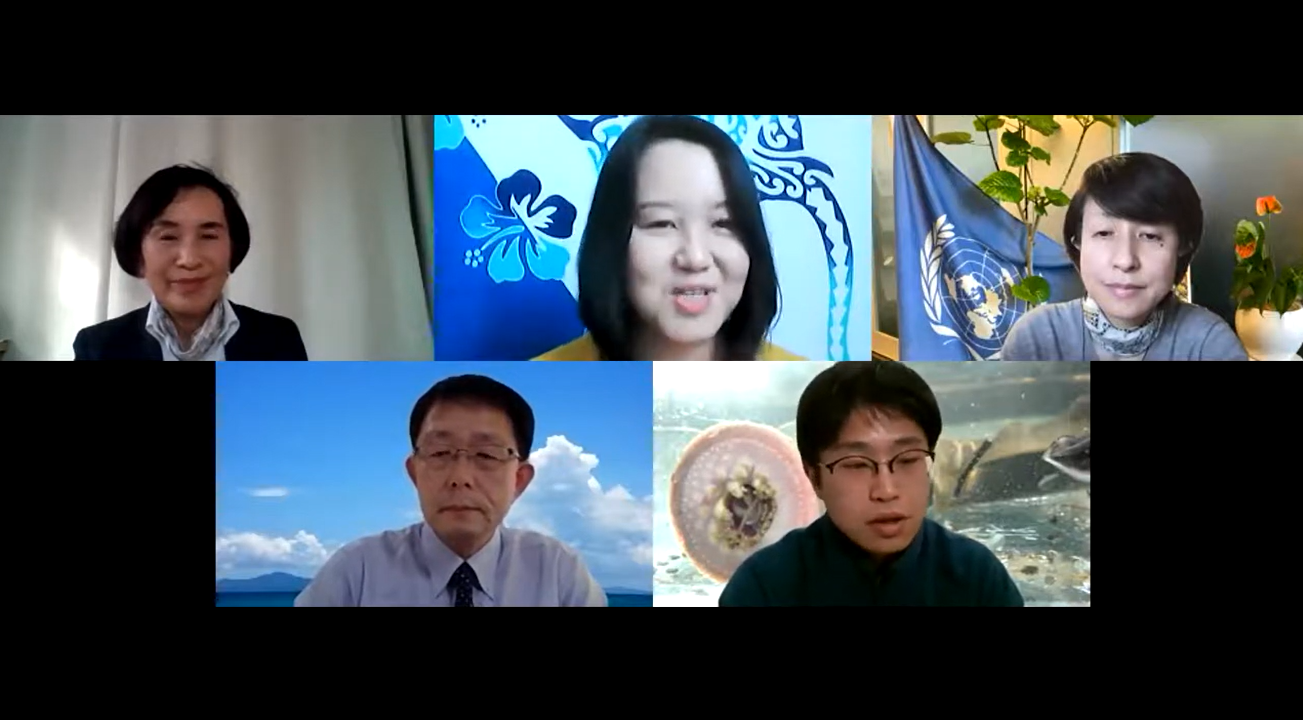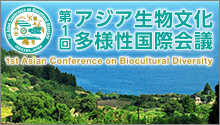This seminar focused on SDG Target 14.3: Reduce ocean acidification, one of the 10 targets of SDG14: Life below Water. This target aims for the alleviation of ocean warming due to global warming as well as ocean acidification.
What SDG14.3 aims for
Although there are many topics regarding environmental issues, such as climate change and biodiversity, one of the important fields is the ocean. SDG14.3 aims to confront and minimise ocean acidification through the promotion of scientific collaboration at all levels. Ocean warming and acidification are two sides of the one coin; however, SDG14.3 focuses on ocean acidification, since SDG13 deals with climate change and global warming.
Keynote lecture: Ocean warming and its impact on living things
The science journalist Tomoyuki Yamamoto gave the keynote lecture on the present condition of the ocean and what it means to us.
A crisis in the coral reef ecosystem
As a result of the 2018 survey of Yabiji, a collection of large coral reef communities near Miyako Island, Okinawa, the living coral area was found to have decreased by 70% in the last decade due to bleaching. Coral reefs are treasure troves of biodiversity, where many living things congregate, and they also function as natural breakwaters to protect the islands from big waves. The IPPC Special Report named Global Warming of 1.5˚C estimates that if the average global temperature rises by 1.5˚C or 2˚C from the pre-industrial level, 70-90% or more than 99% of living coral areas will disappear, respectively.
Rise in air temperature and sea water temperature due to global warming
In the same way as the rise in average global temperature, the global sea-surface temperature has been rising by 0.55˚C per 100 years. In Japan, the sea-surface temperature has risen by 1.14˚C in the last 100 years; thus ocean warming is progressing at a higher pace than the global average. In next 100 years, ocean warming is expected to progress three times faster than before. Oceanic creatures are heavily influenced by sea water temperature rises of 1˚C. If it rises by 3˚C or 4˚C, the biota (ecology) will experience a great change.
Global warming and adaptation measures
Temperature rise also has an influence on fruit. Apple cultivation areas have moved northward and the cultivation of tropical fruit such as passionfruit is increasing on Honshu Island. In farming, adaptation measures for environmental change such as global warming are divided into three categories: improvement in cultivation technology, changing to heat-resistant breeds and changing product types; passionfruit being one example.
Tokushima Prefecture is famous for the cultivation of the brand-name product, Naruto brown seaweed; however, the prefecture is located at the southernmost position among brown seaweed production sites, so it is easily influenced by global warming and its seaweed production is decreasing. Thus, by means of advanced technology the prefecture developed a new breed that is resistant to high water temperature. About 20% of the cultivated brown seaweed in Tokushima has been replaced by the new breed.
Another CO2 problem – ocean acidification
CO2 acts as an acid when dissolved in water. The ocean absorbs a quarter of the CO2 emitted through human activities; therefore, it was believed to help slow global warming. However, the chemical properties of the ocean have changed due to CO2 absorption. If the ocean is acidified, creatures with calcium carbonate shells and skeletons such as sea urchin, shellfish, and coral cannot create them. Ocean acidification is predicted to progress further; according to the worst scenario, its pH level is estimated to drop to 7.8 by the end of this century.
Measures we can take to solve the problem
If CO2 emissions continue at the present pace, global warming and ocean acidification will progress without doubt. At the national level, the government ought to promote the introduction of renewable energy. There is also something consumers can do: introduce new foods into their diets. For instance, we can start eating rabbitfish, since its habitat is spreading northward due to a rise in sea water temperature. Rabbitfish eat large seaweeds such as ecklonia caba (a species of brown alga), causing concern in regards to rocky-shore denudation. If people in more regions start eating rabbitfish, it will contribute not only to the sustainable management of fishery resources but also to the preservation of seaweed beds along the coastlines; we can kill two birds with one stone.
Initiatives for the reduction of CO2 emissions are indispensable for solving the problems of ocean warming and acidification. At the same time, we need to develop measures to survive in an environment where global warming has progressed.
Initiative 1: Warming of satoumi and satoyama from the perspective of fish research
Yusuke Arakawa has been studying lamprey for seven years at Ishikawa Prefectural University Graduate School. He talked about the status of living creatures in the ocean due to influences such as ocean warming, with a focus on the sea around Ishikawa.
If snowfall on Mt. Haku decreases due to global warming, it exerts various influences on nearby satoyama areas: animal damage increases and spring water decreases, affecting living things dependent on spring water, such as pungitis.
There are traditional fishery methods in Noto Peninsula such as mullet towers, fixed net fishing and lethenteron (a species of lamprey) fishing, and they have provided the local people with regional ecological knowledge. The knowledge is useful for bio-resource management; it can be utilised for biodiversity preservation, the sustainable use of bio-resources and evaluation of the impacts of ocean warming and environmental change on fishery resources.
Lethenteron are a sea-run, migratory type of lamprey. In Noto Peninsula, lamprey fishing in spring used to be very popular. They caught lamprey using a tool called the kanko. In those days, a fisherman could catch a drum of lamprey in one day; however, now we can catch one lamprey a day at most. Lamprey are assumed to have decreased, since their distribution area moved northward due to global warming and the construction of dams and banks hindered them from going upstream.
Initiative 2: Action for the future – What we can do to prevent global warming
Next, the environmental counselor Sanae Nakamura talked about the activities in Ishikawa to prevent and counter global warming, and promote education about it.
The IPCC Special Report named Global Warming of 1.5˚C states that for global warming to be limited to 1.5˚C, global CO2 emissions would need to fall by 45% by 2030, reaching net zero around 2050. Japan declared its intention to realise a decarbonised society by 2050, and more and more Japanese companies are joining the RE100 project, which aims for the complete replacement of energy for business operation by renewable energy.
According to Ishikawa Prefecture’s data on CO2 emissions by category, emissions from homes are more than the national average. Emissions from cars and heating devices account for large percentages, and electricity charges are also high. In addition, Japan has a higher food mileage than other industrialised countries, since a large amount of its food is imported and transferred a long distance. One of the reasons for this is the decrease in Japan’s food self-sufficiency rate. Local food production and consumption can be an effective solution to global warming.
We have already affected the environment through our living activities; however, we can change our future by changing our daily activities. Let’s take action now.
Next, a panel discussion was held on the theme of “what we can do to attain the goal for ocean warming and acidisation “. The issues of ocean acidification and the erosion of Chirihama Beach were discussed. These problems are often caused by activities on land. The participants concluded that they would like many people to keep their interest in oceanic environments, enjoy the sea and share its problems, and that they would continue their studies to help achieve that.”
Lastly, Tsunao Watanabe, Director of UNU-IAS OUIK, concluded the seminar by saying, “I hope various initiatives will start in many places in order to realise the targets of SDG14: Life below water.”
The recording of the seminar is available on OUIK’s Youtube channel :




